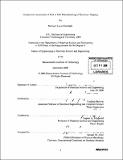Commercial assessment of roll to roll manufacturing of electronic displays
Author(s)
Randolph, Michael Aaron
DownloadFull printable version (17.06Mb)
Other Contributors
Massachusetts Institute of Technology. Dept. of Materials Science and Engineering.
Advisor
Vladimir Bulovic.
Terms of use
Metadata
Show full item recordAbstract
The cost of manufacturing electronic displays currently limits the range of applications and markets into which it is currently economically feasible to adopt displays. Roll-to-roll manufacturing has been identified by the display industry as a new and fundamentally different manufacturing paradigm that has the potential to significantly reduce the manufacturing cost of a display relative to the conventional approaches used in the industry. This manufacturing cost reduction could have a profound impact on the display industry by not only transforming the display manufacturing infrastructure, but also by permitting electronic displays to penetrate new markets. The purpose of this thesis is to determine how roll-to-roll manufacturing technology could develop and to assess what impact the technology could have on the electronic display manufacturing industry. This work first identifies the material, patterning, and equipment technologies that need to come together in order for roll-to-roll manufacturing to be industrially feasible, and then determines how and if the technology will offer a cost reduction over conventional manufacturing techniques. (cont.) Next, the markets for displays are segmented and analyzed to discern whether niche initial markets exist where roll-to-roll could have a distinctive advantage and gain traction. Competitive technologies such as LCD and modular LED are discussed and it is determined that roll-to-roll displays must compete with LCD technology on the basis of price in the markets in which LCD has incumbency in order to achieve widespread adoption. The display industry structure is analyzed by means of an assessment of the supply chain, intellectual property landscape, financing mechanisms, and business models to understand how partnerships and financial investment risk are salient aspects of the commercialization process. It is concluded that materials cost advantages over current manufacturing approaches and the timing of roll-to-roll technology integration developments relative to the incremental manufacturing cost decreases in competing technologies will ultimately dictate the success of roll-to-roll manufacturing.
Description
Thesis (M. Eng.)--Massachusetts Institute of Technology, Dept. of Materials Science and Engineering, 2006. Includes bibliographical references (leaves 76-81).
Date issued
2006Department
Massachusetts Institute of Technology. Department of Materials Science and EngineeringPublisher
Massachusetts Institute of Technology
Keywords
Materials Science and Engineering.